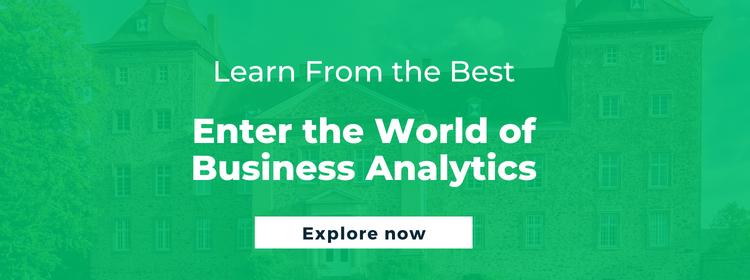Acing a Business Analyst Interview in 2023: A Comprehensive Guide

The present-day business landscape has a plethora of opportunities for the job-seeker. Take the role of a business analyst, for instance. According to the U.S. Bureau of Labor Statistics, business and financial occupations are projected to grow 7% between 2021 and 2031, indicating an increase in employment for professionals across all levels. Further, with the increasing use of data and technology combined with heightened market needs and competition, more and more organizations are on the lookout for skilled business analysts to take their companies to greater heights. So, how do you prepare for a business analyst interview and get an edge over other contenders? Let’s take a look.
How to Prepare for a Business Analyst Interview
The role of a business analyst is diverse in scope and includes responsibilities such as assessing a company’s business objectives, its strategy and facilitating its smooth running, keeping in mind various shareholders. Business analysts also function as project managers and quality testers. The role entails a mix of technical and soft skills. Therefore, while preparing for a business analyst interview, it is necessary to research the company, study the job description, and stay abreast of the latest developments in the business world.
 Scenario-Based/Role-Specific Business Analyst Interview Questions
Scenario-Based/Role-Specific Business Analyst Interview Questions
Define Analytical Reporting
An analytical report is a business document that uses data from various sources to lead to a conclusion that could potentially resolve persistent issues, identify growth opportunities, and drive decision-making.
Tell Me the Difference Between Exception Flow and Alternate Flow
An exception flow comprises a sequence of steps that does not achieve the desired outcome. It is an unintentional path taken through the system often due to misinformation or system availability problems. Alternate flow refers to a series of actions in a non-random and repeatable order that achieves the use case’s goal while diverting from the basic flow.
What are Non-Functional Requirements and How Do You Capture Them?
Non-Functional Requirements (NFRs) comprise qualities such as reliability, security, scalability, performance, maintainability, and usability. To capture NFRs, analysts often record their metrics manually or use digital tools like Google Analytics for recognizing unique identifiers.
What Are the Different Types of Diagrams You Use as a Business Analyst? How Do They Impact the Work?
Here are some diagrams commonly used by business analysts:
- Activity diagram: Used by business and development teams to communicate processes to stakeholders
- Feature mind maps: Used while brainstorming to capture and categorize ideas, concepts, and concerns
- Product roadmaps: Outlines the development and launches of a product and its attributes that help developers add value to the user
- Organizational chart: Used as a reference to understand a company’s organization and hierarchy
- SWOT analysis: A thorough assessment of the business to identify its strengths, weaknesses, opportunities, and threats
 Tell Me the Best Way to Influence Multiple Stakeholders in a Project. How Do You Deal With Difficult Stakeholders?
Tell Me the Best Way to Influence Multiple Stakeholders in a Project. How Do You Deal With Difficult Stakeholders?
The first step is to map out the stakeholders, understand their motivations, and prioritize them based on available time and resources. A thorough plan of communication and implementation also serves this purpose. That said, business analysts must be flexible in their approach while dealing with difficult stakeholders as such situations need them to adapt and negotiate wisely.
Tell Me the Difference Between a Requirement and a Need in Business Analysis
Simply put, business needs refer to the business objectives and aims outlined by an organization while requirements are the necessary steps taken to achieve said objectives. In this regard, requirements are more specific and detailed than needs.
Which Documents are Used to Capture Non-Functional Requirements?
Definition of Done (DoD), acceptance criteria, mock-ups, spreadsheets, product backlogs, and sprint backlogs are used to capture NFRs.
How Can You Manage the Post-Implementation and Pre-Implementation Problems of a Project?
Analysts and project managers conduct a post-implementation review at the end of a project to determine its success and identify areas for improvement. Similarly, in the pre-implementation stage, it is imperative to ensure adequate resource allocation, a consensus regarding the project objective, and clarity on business requirements.
Tell Me the Importance of Requirement Prioritization. Tell Me the Technique Used
As organizations have finite resources, requirement prioritization helps avoid a scarcity of resources or overallocation of the same. For this, analysts use methods like ranking, grouping, MoScoW method, bubbles sort technique, Hundred Dollar method, analytic hierarchy process, and Kano analysis.
What is Scope Creep and How Can You Avoid it?
When the project scope is changed without having control measures in place, the resultant disruption is called scope creep. This affects the business schedule, budget, allocation, and even completion. Some ways to avoid it would be to formulate scope, change, and risk management plans.
 How Do You Manage Frequently Changing Customer Requirements?
How Do You Manage Frequently Changing Customer Requirements?
Flexibility is key to handling changing customer requirements. Some of the ways to do this are:
- Assessing the impact of the change on the final outcome/product
- Creating an accessible database of key requirements to use as a reference during processing change requests
- Using the database to maintain transparency in data and for future reference
Do You Think a Business Analyst Should Be Involved in Testing?
Yes, they should be closely involved as they have a thorough knowledge of the field and a strong grasp of the product’s functional requirements. Therefore, a business analyst is perfectly positioned to guide testers in designing test cases and understanding functionality.
Tell Me the Importance of Personas in User-Centered Design Methodology
Personas help businesses identify with users, easing the design and ideation processes. They also lead to better user experiences for the target group.
Industries and Companies That Benefit Most from Business Analysts
Banking, security, media, healthcare and pharmaceuticals, education, manufacturing, insurance, energy and power, and government domains are some of the industries that have the most useful for business analysts.
Business analytics is a booming field that offers attractive salary packages, immense job prestige, and opportunities for career advancement. If you want to ace that business analyst interview, make sure your knowledge is up-to-date by signing up for the curated business analytics courses offered by Emeritus.
By Deyasini Chatterjee
Write to us at content@emeritus.org














